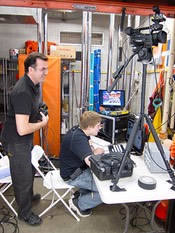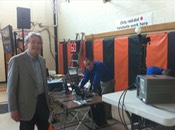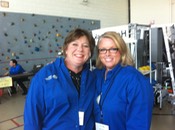Up until electronic voting for Wayland's New England town meeting, all New England towns, used manual methods of tallying the votes. Each of these pre-technology methods depended upon the two senses of the human being. Sound and Sight. Each of these methods always divides the audience into Aye and Nay.
The fastest way to measure the vote is to ask people to shout out Aye and Nay - separately.
Unfortunately the human sense of hearing is also terribly inaccurate. Sound volume drops off with distance. A person sitting 10 feet away from the moderator will appear twice as loud as a person sitting 20 feet away. The closer you are to the moderator and the louder you shout, the more your vote will appear to count. Voice voting only really works well when the result is virtually unanimous and voice voting is a terrible way to measure votes which require 2/3rds quantum. That is, 2/3rds of the audience has to agree to pass the measure. When voice voting does not work or is not fit for the purpose then we must resort to the the 'standing counted vote'.
The 'standing counted vote' (SCV) requires time and personnel. Pairs of tellers roam the room checking off standing people for Aye and then roam the room once again, checking off standing people for Nay.
We have enough experience with traditional voting to know that an audience of 350 people will take between 15-25 minutes to adequately count. We also know that the likelihood of having a 'standing counted vote' increases as the margin of difference between shouted Aye and shouted Nay closes. The trigger point of the SCV starts to significantly appear when that margin of difference drops to 20%. As the margin goes to 15% or 10% or 5% or less - we can assume that we will have to perform a lengthly SCV.
Some towns use the meeting divided 'show of hands' or the meeting divided 'stand up for a few seconds' to gauge the count. But when that difference is only 20% or less then the trigger to require a more precise SCV will appear.
When the quantum of vote is 2/3rds (as it is for zoning or borrowing) then legally, we must know the count. In the past, the moderator would hope the margin is virtually unanamous and sometimes even ask for a re-shout to try to get unanamous.
The traditional methods trade off speed for accuracy. Electronic voting makes no such tradeoff.
In Wayland's electronic voting we open the voting window for 30 seconds. With instructions and formalities we take no more than 1 minute for every vote. We never have a SCV. We always get the precise answer to every vote.
Based on three sessions worth of electronic voting data - we can show you calculations of how much time we would have saved by not performing the SCV as follows:
SCV April-2011 SCV April-2012 SCV Oct-2012 SCV April-2013



